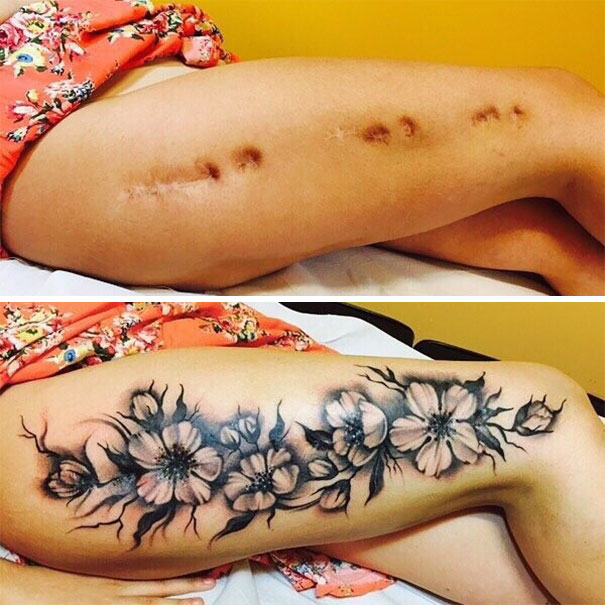Transforming Scars into Stories: The Art of Tattoo Cover-Ups
Our bodies tell stories. Sometimes, those stories are etched into our skin in the form of scars. While some people wear their scars as badges of honor, others may seek ways to reclaim their bodies and rewrite those narratives. For many, a scar tattoo cover-up offers a powerful way to transform what was once a source of discomfort or insecurity into a beautiful and empowering piece of art.
Scar cover-up tattoos are more than just ink on skin; they're a fusion of artistry and empathy. Imagine a skilled tattoo artist using their tools not just to draw but to heal, to help you reclaim your body and tell a new story, one that celebrates your resilience and individuality.
The decision to get a scar cover-up tattoo is a deeply personal one. It's about taking ownership of your body and choosing how you want to adorn it. It's about transforming a mark that may have carried negative emotions into a symbol of strength, beauty, or simply a design that brings you joy.
This journey often starts with extensive research. Finding a tattoo artist who specializes in scar cover-ups and whose style resonates with you is crucial. Look at their portfolio, read reviews, and don't hesitate to schedule consultations to discuss your vision, concerns, and expectations. Remember, this is a collaboration, and open communication with your artist is key to achieving the best results.
Before taking the plunge, it's essential to understand the unique considerations that come with scar tattoo cover-ups. Scars present a different canvas than unscarred skin. Factors like scar tissue texture, color, and the age of the scar can influence the design and ink application. A skilled artist will take all of this into account, guiding you towards a design that complements your scar while achieving your desired aesthetic.
Advantages and Disadvantages of Scar Cover-Up Tattoos
| Advantages | Disadvantages |
|---|---|
| Camouflages scars | May not completely hide the scar |
| Boosts confidence and self-esteem | Requires careful consideration and planning |
| Transforms a negative into a positive | Can be more expensive than traditional tattoos |
| Offers a creative outlet for self-expression | May require multiple sessions depending on the scar and design |
Best Practices for Scar Cover-Up Tattoos
1. Research and Choose a Specialist: Look for artists experienced in scar cover-ups, examine their portfolios, and schedule consultations.
2. Open Communication: Discuss your scar's history, desired design, and any concerns with your chosen artist.
3. Manage Expectations: Understand that complete scar invisibility might not be achievable; focus on creating a design you love.
4. Prioritize Aftercare: Follow your artist's instructions diligently for optimal healing and ink settling.
5. Patience is Key: Healing takes time, and the final result might not be visible for several weeks. Trust the process and allow your tattoo to heal fully.
Frequently Asked Questions
1. Can any scar be covered with a tattoo? Most scars can be tattooed, but factors like scar type, age, and location impact design options. Consult a specialist for assessment.
2. How much does a scar cover-up tattoo cost? Costs vary based on size, complexity, artist's rates, and location. Discuss budget openly during consultations.
3. Does getting a tattoo over a scar hurt more? Pain tolerance is subjective, but scar tissue can be more sensitive. Discuss pain management options with your artist.
4. How long after a scar heals can I get a tattoo? Most artists recommend waiting at least a year for complete healing. Consult a dermatologist and your tattoo artist for personalized advice.
5. Will the tattoo fade differently on scar tissue? Scar tissue might hold ink differently, potentially leading to slight fading variations. Touch-ups can address any changes over time.
6. Can I bring my own design for a scar cover-up? Yes, but be open to artist suggestions for adapting it to your scar's unique characteristics. Collaboration is key.
7. What if I'm not happy with the final result of my scar cover-up tattoo? Communicate any concerns with your artist. They might offer touch-ups or adjustments to ensure your satisfaction.
8. Are there any risks associated with scar cover-up tattoos? As with any tattoo, infection is a risk if proper aftercare isn't followed. Choose a reputable artist who prioritizes hygiene.
Tips and Tricks
- Look for inspiration online and save images of cover-up tattoos you like to share with your artist.
- Consider the color palette carefully, as some colors might complement your skin tone and scar better than others.
- Don't be afraid to ask your artist about their experience and success stories with scar cover-up tattoos.
Scar cover-up tattoos are more than just a way to conceal; they're a transformative journey of reclaiming your body and embracing your story. By understanding the process, finding a skilled and compassionate artist, and prioritizing open communication, you can embark on this empowering experience and transform your scars into beautiful, meaningful works of art that reflect the strength and resilience within you. Remember, your body is your own, and you have the power to decide how you want to adorn it and what story you want it to tell.

best scar tattoo cover up | Kennecott Land

best scar tattoo cover up | Kennecott Land

best scar tattoo cover up | Kennecott Land

best scar tattoo cover up | Kennecott Land

best scar tattoo cover up | Kennecott Land

best scar tattoo cover up | Kennecott Land

best scar tattoo cover up | Kennecott Land

best scar tattoo cover up | Kennecott Land

best scar tattoo cover up | Kennecott Land

best scar tattoo cover up | Kennecott Land

Tattoos: Anybody have regrets or wild stories ?? | Kennecott Land

best scar tattoo cover up | Kennecott Land

best scar tattoo cover up | Kennecott Land

best scar tattoo cover up | Kennecott Land

best scar tattoo cover up | Kennecott Land